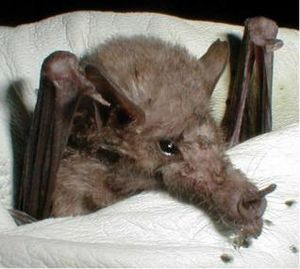Mexican long-tongued bat facts for kids
Quick facts for kids Mexican long-tongued bat |
|
|---|---|
 |
|
| Conservation status | |
| Scientific classification | |
| Genus: |
Choeronycteris
|
| Species: |
mexicana
|
 |
|
| Mexican long-tongued bat range | |
The Mexican long-tongued bat (Choeronycteris mexicana) is a special type of bat found in North and Central America. It's the only species in its group, called Choeronycteris. These bats are known for their long tongues, which help them drink nectar from flowers, just like hummingbirds! You can find them in countries like Mexico, the United States, El Salvador, Guatemala, and Honduras.
Contents
What's in a Name?
The name Choeronycteris comes from ancient Greek words. Choiros means "pig," and nykteris means "bat." So, it's like "pig-bat," probably because of its snout! The second part of its name, mexicana, simply tells us where it lives – Mexico.
Meet the Mexican Long-Tongued Bat
This bat is a medium-sized member of the bat family called Phyllostomidae. Its fur can be up to 7 mm long. It's usually gray or brownish, but can be lighter on its shoulders. Its wings are a darker brownish-gray with lighter tips. The ears match its body color and can be different sizes. This bat has a short tail. It usually weighs between 10 and 20 grams. Pregnant females can weigh up to 25 grams.
Special Features
The Mexican long-tongued bat has a very long snout. At the end of its snout is a small, leaf-like shape about 5 mm long. Its tongue is long, thin, and can stretch out far. This special tongue helps it reach nectar deep inside flowers. The tongue is covered with tiny, hair-like bumps. These bumps become harder towards the base of the tongue.
Its skull is about 30 mm long. The front part of its skull, called the rostrum, makes up almost half of this length. Young bats have 22 baby teeth. These teeth fall out and are replaced by 30 adult teeth.
How They "See" in the Dark
Like all microbats, Mexican long-tongued bats use echolocation. This means they send out high-pitched sounds. They listen for the echoes that bounce back from objects. This helps them "see" their surroundings and find food in the dark. They are very good at hearing high-frequency sounds, especially between 65–80 kHz. They can also hear lower sounds around 5 kHz.
Where They Live
In the United States, you can find these bats in southern California, New Mexico, and Arizona. They have also been seen in Texas. Further south, their home stretches through Mexico, including Baja California and the Tres Marias Islands. They also live in El Salvador, Honduras, and Guatemala.
Their Homes
These bats live in areas from 300 to 2,400 meters above sea level. They prefer forests where trees lose their leaves, dry thorny bushes, and mixed oak-pine forests. Bats living in the northern parts of their range fly south for the winter. This is a type of migration.
Bat Life: Diet and Behavior
What They Eat
The Mexican long-tongued bat loves to eat nectar and pollen from plants like agaves. They also eat fruits from other plants. Their super long tongue can stretch out up to one-third of their body length! This helps them reach the sweet nectar deep inside blossoms. In southern Arizona, they sometimes even visit hummingbird feeders for a quick snack!
Daily Habits
During the day, these bats rest in caves or old, empty buildings. They don't huddle together. Instead, they hang about 2–5 cm apart. They hang by just one foot, which lets them spin around on their perch. If something scares them, they fly towards the opening and light. They don't fly deeper into their roosting spot.
Why They Travel
These bats migrate to follow where nectar is available. They move to places where their favorite flowers are blooming. Scientists believe that larger bats, like the Mexican long-tongued bat, can store more energy. This helps them travel long distances over areas without much food. This might be why they migrate, while their smaller relatives, like the Banana bat, stay in one place. Bats that stay in one area know their small home very well. They know where to find all kinds of food, even less tasty ones. Migrating bats, however, tend to look for big, reliable sources of high-quality food.
Reproduction and Life Cycle
Mexican long-tongued bats usually breed between June and September in places like Arizona and New Mexico. Farther south, they might breed earlier. Sometimes, they even have a second breeding season there. Females usually give birth to one baby at a time. However, two babies have been reported in Guatemala.
During pregnancy and when the babies are born, male and female bats live separately. The young bats are born with fur. They start flying when they are about 4–6 weeks old.
Protecting These Bats
The Mexican long-tongued bat is currently listed as Near Threatened by the IUCN. This means they could become endangered if their habitat continues to shrink. Their homes, especially caves, are being lost due to mining and tourism. Because of these threats, they are considered a "Species of Special Concern" in California and Arizona. Protecting their homes is important to help these unique bats survive.
See also
 In Spanish: Murciélago hociquilargo mexicano para niños
In Spanish: Murciélago hociquilargo mexicano para niños


